Ana Davila
Embedded Image-to-Image Translation for Efficient Sim-to-Real Transfer in Learning-based Robot-Assisted Soft Manipulation
Sep 16, 2024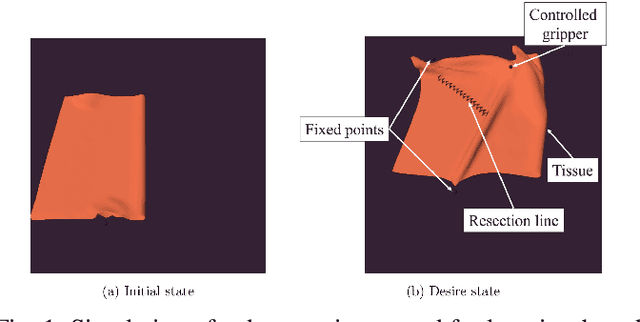

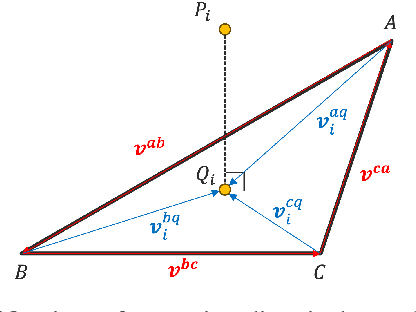
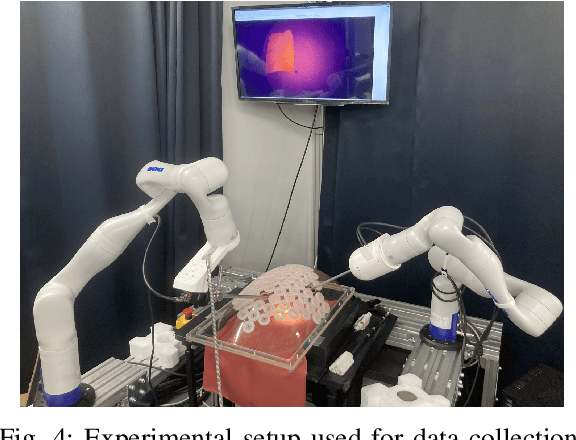
Abstract:Recent advances in robotic learning in simulation have shown impressive results in accelerating learning complex manipulation skills. However, the sim-to-real gap, caused by discrepancies between simulation and reality, poses significant challenges for the effective deployment of autonomous surgical systems. We propose a novel approach utilizing image translation models to mitigate domain mismatches and facilitate efficient robot skill learning in a simulated environment. Our method involves the use of contrastive unpaired Image-to-image translation, allowing for the acquisition of embedded representations from these transformed images. Subsequently, these embeddings are used to improve the efficiency of training surgical manipulation models. We conducted experiments to evaluate the performance of our approach, demonstrating that it significantly enhances task success rates and reduces the steps required for task completion compared to traditional methods. The results indicate that our proposed system effectively bridges the sim-to-real gap, providing a robust framework for advancing the autonomy of surgical robots in minimally invasive procedures.
Voice control interface for surgical robot assistants
Sep 16, 2024Abstract:Traditional control interfaces for robotic-assisted minimally invasive surgery impose a significant cognitive load on surgeons. To improve surgical efficiency, surgeon-robot collaboration capabilities, and reduce surgeon burden, we present a novel voice control interface for surgical robotic assistants. Our system integrates Whisper, state-of-the-art speech recognition, within the ROS framework to enable real-time interpretation and execution of voice commands for surgical manipulator control. The proposed system consists of a speech recognition module, an action mapping module, and a robot control module. Experimental results demonstrate the system's high accuracy and inference speed, and demonstrates its feasibility for surgical applications in a tissue triangulation task. Future work will focus on further improving its robustness and clinical applicability.
A hierarchical framework for collision avoidance in robot-assisted minimally invasive surgery
Sep 16, 2024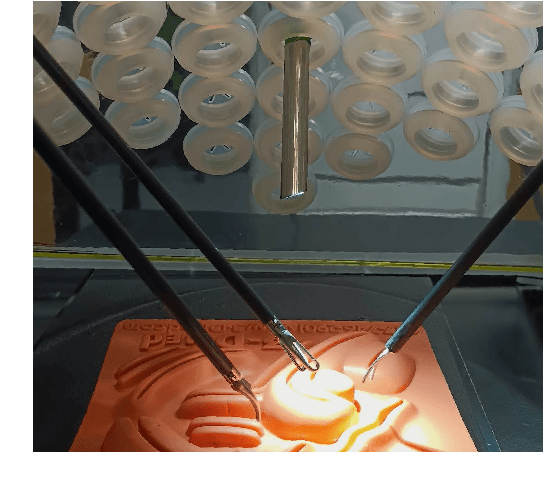

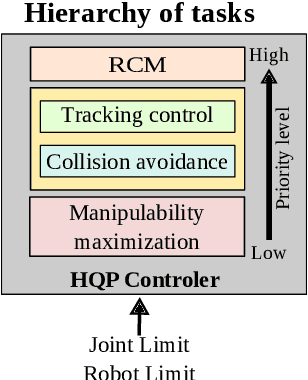
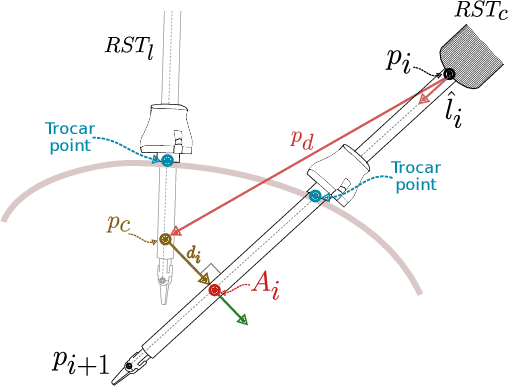
Abstract:Minimally invasive surgery (MIS) procedures benefit significantly from robotic systems due to their improved precision and dexterity. However, ensuring safety in these dynamic and cluttered environments is an ongoing challenge. This paper proposes a novel hierarchical framework for collision avoidance in MIS. This framework integrates multiple tasks, including maintaining the Remote Center of Motion (RCM) constraint, tracking desired tool poses, avoiding collisions, optimizing manipulability, and adhering to joint limits. The proposed approach utilizes Hierarchical Quadratic Programming (HQP) to seamlessly manage these constraints while enabling smooth transitions between task priorities for collision avoidance. Experimental validation through simulated scenarios demonstrates the framework's robustness and effectiveness in handling diverse scenarios involving static and dynamic obstacles, as well as inter-tool collisions.
Comparison of fine-tuning strategies for transfer learning in medical image classification
Jun 14, 2024Abstract:In the context of medical imaging and machine learning, one of the most pressing challenges is the effective adaptation of pre-trained models to specialized medical contexts. Despite the availability of advanced pre-trained models, their direct application to the highly specialized and diverse field of medical imaging often falls short due to the unique characteristics of medical data. This study provides a comprehensive analysis on the performance of various fine-tuning methods applied to pre-trained models across a spectrum of medical imaging domains, including X-ray, MRI, Histology, Dermoscopy, and Endoscopic surgery. We evaluated eight fine-tuning strategies, including standard techniques such as fine-tuning all layers or fine-tuning only the classifier layers, alongside methods such as gradually unfreezing layers, regularization based fine-tuning and adaptive learning rates. We selected three well-established CNN architectures (ResNet-50, DenseNet-121, and VGG-19) to cover a range of learning and feature extraction scenarios. Although our results indicate that the efficacy of these fine-tuning methods significantly varies depending on both the architecture and the medical imaging type, strategies such as combining Linear Probing with Full Fine-tuning resulted in notable improvements in over 50% of the evaluated cases, demonstrating general effectiveness across medical domains. Moreover, Auto-RGN, which dynamically adjusts learning rates, led to performance enhancements of up to 11% for specific modalities. Additionally, the DenseNet architecture showed more pronounced benefits from alternative fine-tuning approaches compared to traditional full fine-tuning. This work not only provides valuable insights for optimizing pre-trained models in medical image analysis but also suggests the potential for future research into more advanced architectures and fine-tuning methods.
* Accepted at Image and Vision Computing
Manipulability maximization in constrained inverse kinematics of surgical robots
Jun 14, 2024Abstract:In robot-assisted minimally invasive surgery (RMIS), inverse kinematics (IK) must satisfy a remote center of motion (RCM) constraint to prevent tissue damage at the incision point. However, most of existing IK methods do not account for the trade-offs between the RCM constraint and other objectives such as joint limits, task performance and manipulability optimization. This paper presents a novel method for manipulability maximization in constrained IK of surgical robots, which optimizes the robot's dexterity while respecting the RCM constraint and joint limits. Our method uses a hierarchical quadratic programming (HQP) framework that solves a series of quadratic programs with different priority levels. We evaluate our method in simulation on a 6D path tracking task for constrained and unconstrained IK scenarios for redundant kinematic chains. Our results show that our method enhances the manipulability index for all cases, with an important increase of more than 100% when a large number of degrees of freedom are available. The average computation time for solving the IK problems was under 1ms, making it suitable for real-time robot control. Our method offers a novel and effective solution to the constrained IK problem in RMIS applications.
* Accepted at 2023 IEEE International Conference on Mechatronics and Automation (ICMA)
Task segmentation based on transition state clustering for surgical robot assistance
Jun 14, 2024Abstract:Understanding surgical tasks represents an important challenge for autonomy in surgical robotic systems. To achieve this, we propose an online task segmentation framework that uses hierarchical transition state clustering to activate predefined robot assistance. Our approach involves performing a first clustering on visual features and a subsequent clustering on robot kinematic features for each visual cluster. This enables to capture relevant task transition information on each modality independently. The approach is implemented for a pick-and-place task commonly found in surgical training. The validation of the transition segmentation showed high accuracy and fast computation time. We have integrated the transition recognition module with predefined robot-assisted tool positioning. The complete framework has shown benefits in reducing task completion time and cognitive workload.
* Accepted at 2023 International Conference on Control and Robotics Engineering (ICCRE)
Constrained Motion Planning for a Robotic Endoscope Holder based on Hierarchical Quadratic Programming
Jun 14, 2024Abstract:Minimally Invasive Surgeries (MIS) are challenging for surgeons due to the limited field of view and constrained range of motion imposed by narrow access ports. These challenges can be addressed by robot-assisted endoscope systems which provide precise and stabilized positioning, as well as constrained and smooth motion control of the endoscope. In this work, we propose an online hierarchical optimization framework for visual servoing control of the endoscope in MIS. The framework prioritizes maintaining a remote-center-of-motion (RCM) constraint to prevent tissue damage, while a visual tracking task is defined as a secondary task to enable autonomous tracking of visual features of interest. We validated our approach using a 6-DOF Denso VS050 manipulator and achieved optimization solving times under 0.4 ms and maximum RCM deviation of approximately 0.4 mm. Our results demonstrate the effectiveness of the proposed approach in addressing the constrained motion planning challenges of MIS, enabling precise and autonomous endoscope positioning and visual tracking.
* Accepted at 2023 International Conference on Control and Robotics Engineering (ICCRE)
 Add to Chrome
Add to Chrome Add to Firefox
Add to Firefox Add to Edge
Add to Edge